19. 03. 16 Lecture 5. Man and Materials
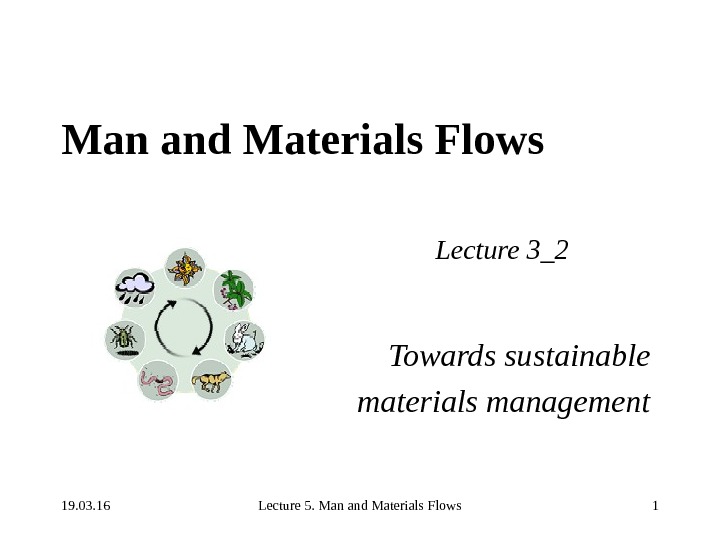
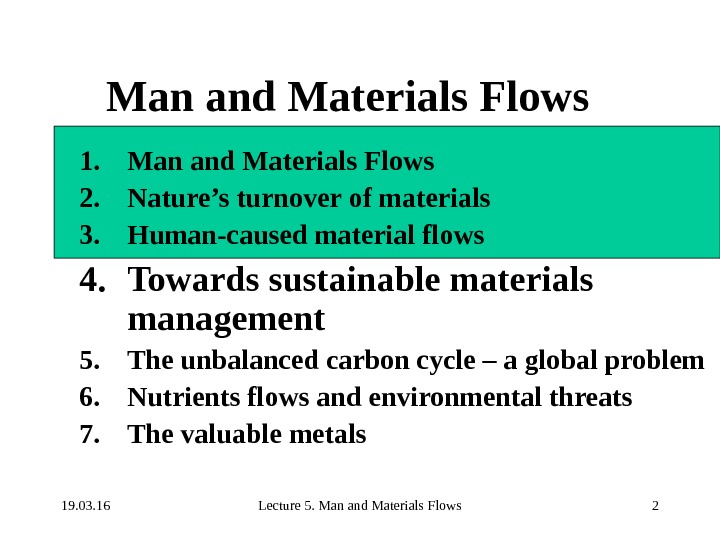
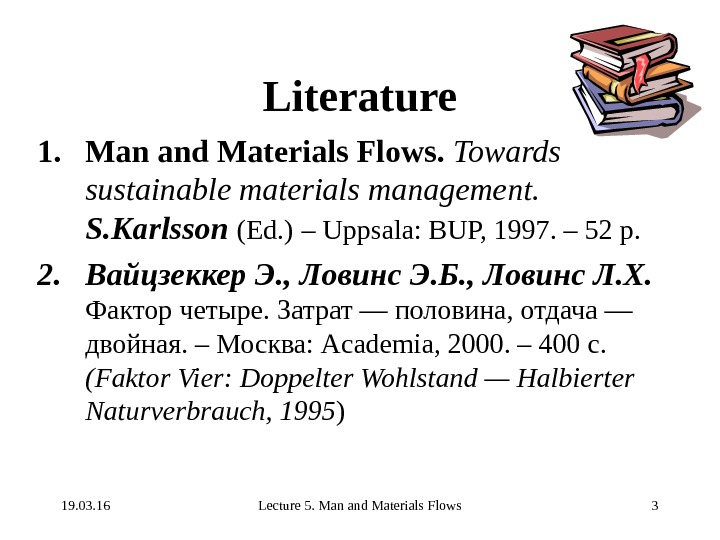
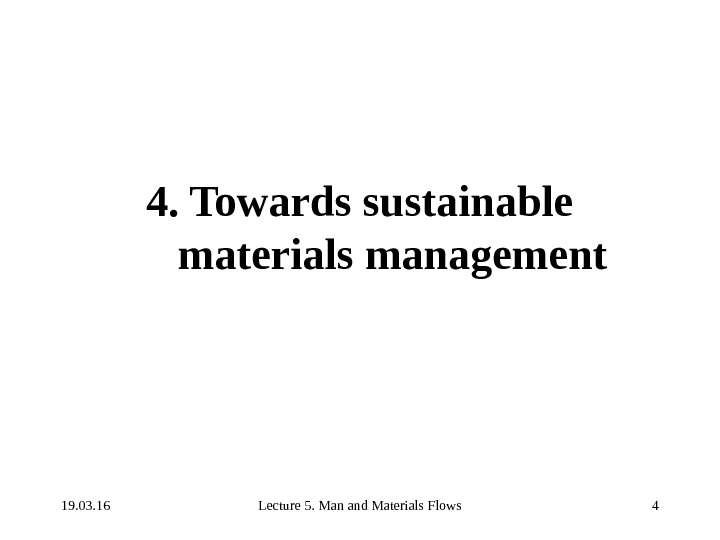
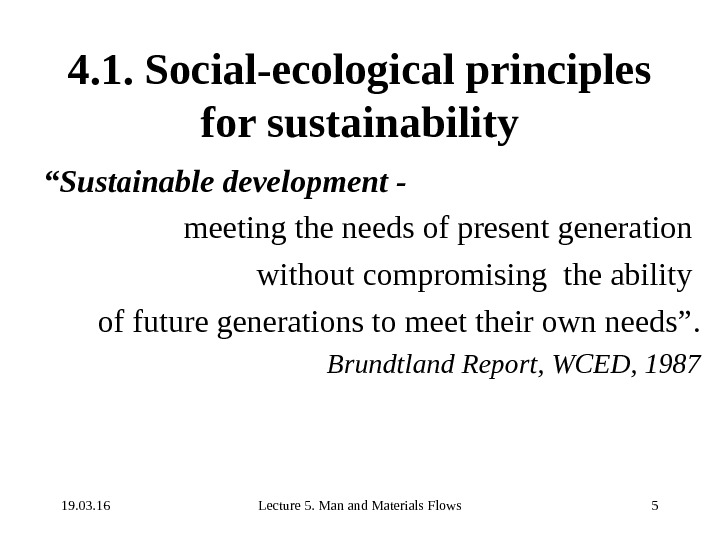
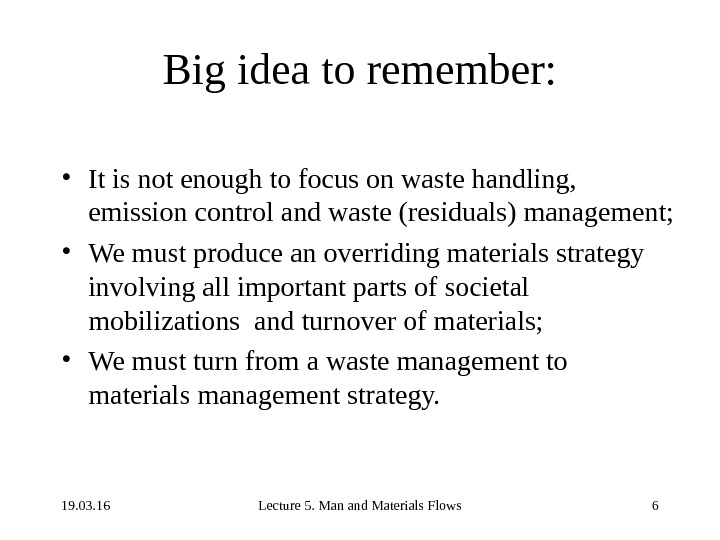


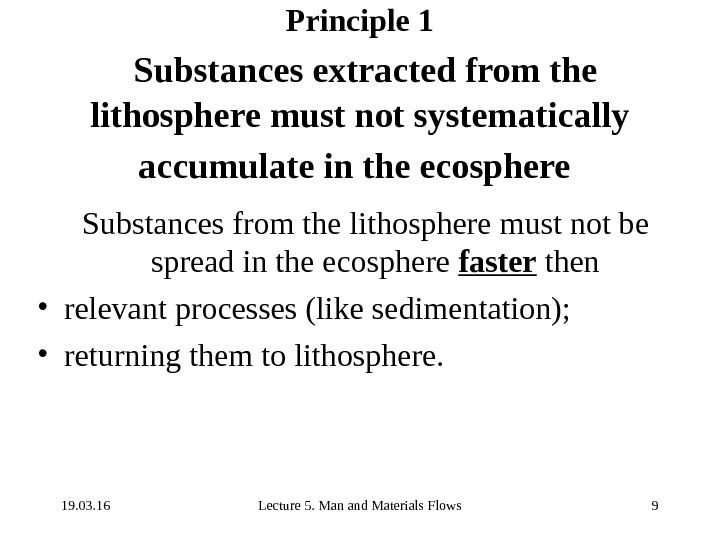
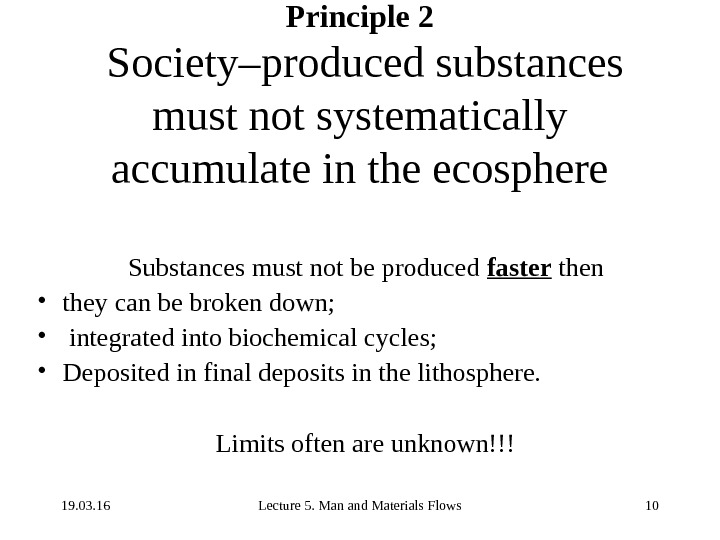

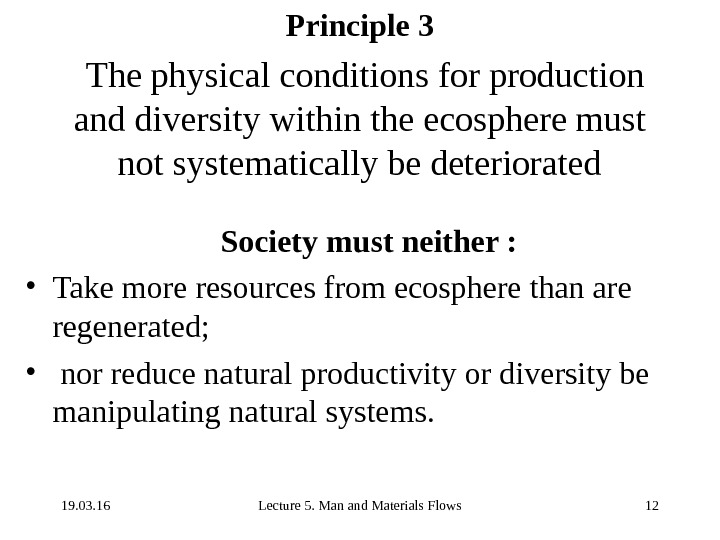


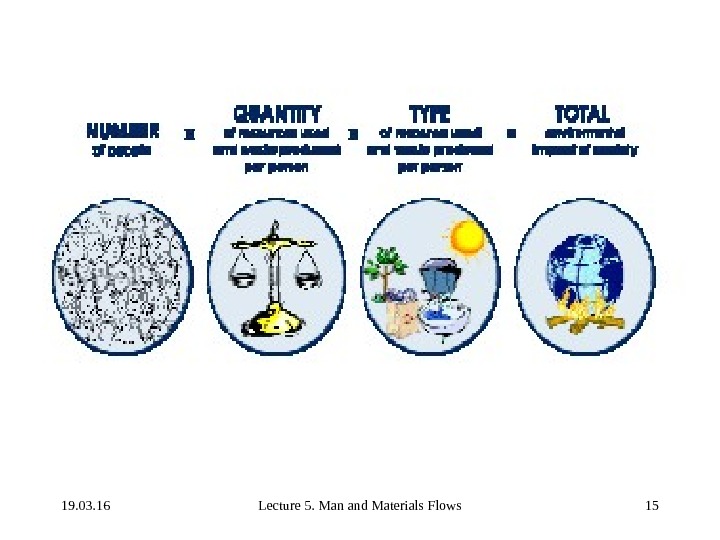

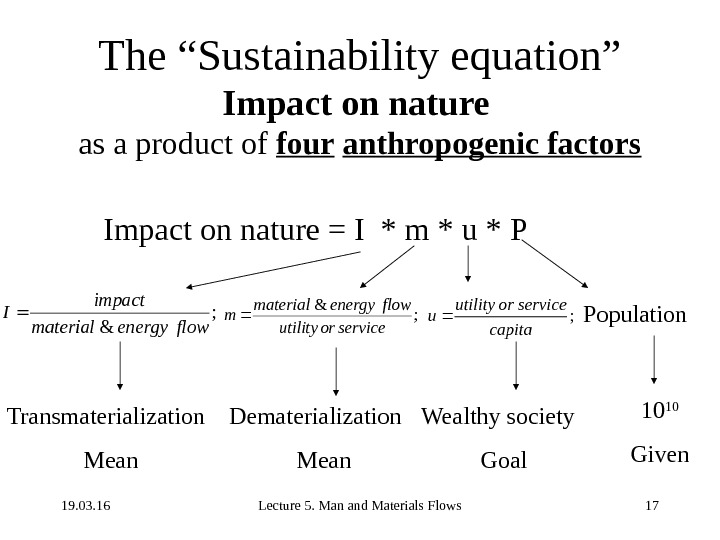


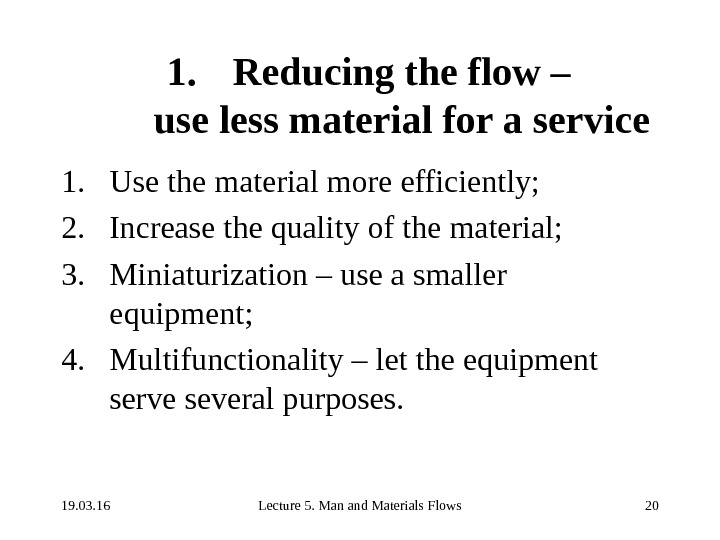


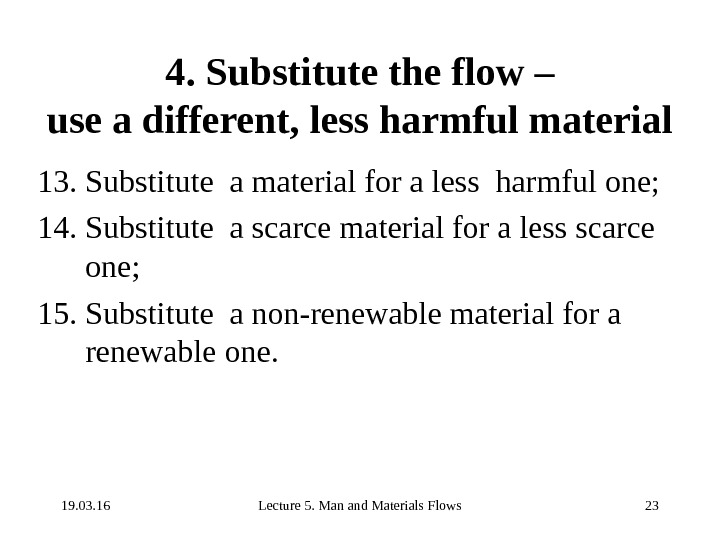
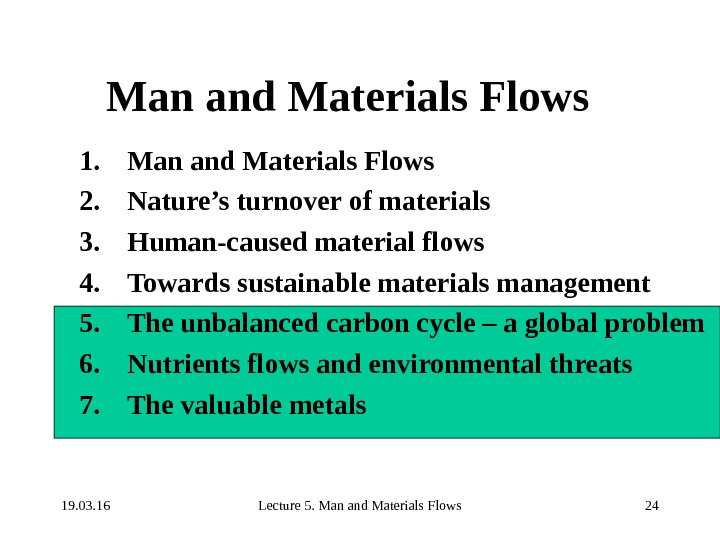
- Размер: 318.5 Кб
- Количество слайдов: 24
Описание презентации 19. 03. 16 Lecture 5. Man and Materials по слайдам
 19. 03. 16 Lecture 5. Man and Materials Flows 1 Man and Materials Flows Lecture 3 _ 2 Towards sustainable materials management
19. 03. 16 Lecture 5. Man and Materials Flows 1 Man and Materials Flows Lecture 3 _ 2 Towards sustainable materials management
 19. 03. 16 Lecture 5. Man and Materials Flows 2 Man and Materials Flows 1. Man and Materials Flows 2. Nature’s turnover of materials 3. Human-caused material flows 4. Towards sustainable materials management 5. The unbalanced carbon cycle – a global problem 6. Nutrients flows and environmental threats 7. The valuable metals
19. 03. 16 Lecture 5. Man and Materials Flows 2 Man and Materials Flows 1. Man and Materials Flows 2. Nature’s turnover of materials 3. Human-caused material flows 4. Towards sustainable materials management 5. The unbalanced carbon cycle – a global problem 6. Nutrients flows and environmental threats 7. The valuable metals
 19. 03. 16 Lecture 5. Man and Materials Flows 3 Literature 1. Man and Materials Flows. Towards sustainable materials management. S. Karlsson (Ed. ) – Uppsala: BUP, 1997. – 52 p. 2. Вайцзеккер Э. , Ловинс Э. Б. , Ловинс Л. Х. Фактор четыре. Затрат — половина, отдача — двойная. – Москва: Academia, 2000. – 400 c. ( Faktor Vier : Doppelter Wohlstand — Halbierter Naturverbrauch, 1995 )
19. 03. 16 Lecture 5. Man and Materials Flows 3 Literature 1. Man and Materials Flows. Towards sustainable materials management. S. Karlsson (Ed. ) – Uppsala: BUP, 1997. – 52 p. 2. Вайцзеккер Э. , Ловинс Э. Б. , Ловинс Л. Х. Фактор четыре. Затрат — половина, отдача — двойная. – Москва: Academia, 2000. – 400 c. ( Faktor Vier : Doppelter Wohlstand — Halbierter Naturverbrauch, 1995 )
 19. 03. 16 Lecture 5. Man and Materials Flows 44. Towards sustainable materials management
19. 03. 16 Lecture 5. Man and Materials Flows 44. Towards sustainable materials management
 19. 03. 16 Lecture 5. Man and Materials Flows 54. 1. Social-ecological principles for sustainability “ Sustainable development — meeting the needs of present generation without compromising the ability of future generations to meet their own needs”. Brundtland Report, WCED,
19. 03. 16 Lecture 5. Man and Materials Flows 54. 1. Social-ecological principles for sustainability “ Sustainable development — meeting the needs of present generation without compromising the ability of future generations to meet their own needs”. Brundtland Report, WCED,
 19. 03. 16 Lecture 5. Man and Materials Flows 6 Big idea to remember: • It is not enough to focus on waste handling, emission control and waste (residuals) management; • We must produce an overriding materials strategy involving all important parts of societal mobilizations and turnover of materials; • We must turn from a waste management to materials management strategy.
19. 03. 16 Lecture 5. Man and Materials Flows 6 Big idea to remember: • It is not enough to focus on waste handling, emission control and waste (residuals) management; • We must produce an overriding materials strategy involving all important parts of societal mobilizations and turnover of materials; • We must turn from a waste management to materials management strategy.
 19. 03. 16 Lecture 5. Man and Materials Flows 7 Principles for the exchange flows between society and nature, Holmberg et. al. , 1994 1. Substances extracted from the lithosphere must not systematically accumulate in the ecosphere. 2. Society–produced substances must not systematically accumulate in the ecosphere. 3. The physical conditions for production and diversity within the ecosphere must not systematically be deteriorated. 4. The use of resources must be efficient and just with respect to meeting human needs.
19. 03. 16 Lecture 5. Man and Materials Flows 7 Principles for the exchange flows between society and nature, Holmberg et. al. , 1994 1. Substances extracted from the lithosphere must not systematically accumulate in the ecosphere. 2. Society–produced substances must not systematically accumulate in the ecosphere. 3. The physical conditions for production and diversity within the ecosphere must not systematically be deteriorated. 4. The use of resources must be efficient and just with respect to meeting human needs.
 19. 03. 16 Lecture 5. Man and Materials Flows 8 Principles 1 and 2 Turnover in balance
19. 03. 16 Lecture 5. Man and Materials Flows 8 Principles 1 and 2 Turnover in balance
 19. 03. 16 Lecture 5. Man and Materials Flows 9 Principle 1 Substances extracted from the lithosphere must not systematically accumulate in the ecosphere Substances from the lithosphere must not be spread in the ecosphere faster then • relevant processes (like sedimentation); • returning them to lithosphere.
19. 03. 16 Lecture 5. Man and Materials Flows 9 Principle 1 Substances extracted from the lithosphere must not systematically accumulate in the ecosphere Substances from the lithosphere must not be spread in the ecosphere faster then • relevant processes (like sedimentation); • returning them to lithosphere.
 19. 03. 16 Lecture 5. Man and Materials Flows 10 Principle 2 Society–produced substances must not systematically accumulate in the ecosphere Substances must not be produced faster then • they can be broken down; • integrated into biochemical cycles; • Deposited in final deposits in the lithosphere. Limits often are unknown!!!
19. 03. 16 Lecture 5. Man and Materials Flows 10 Principle 2 Society–produced substances must not systematically accumulate in the ecosphere Substances must not be produced faster then • they can be broken down; • integrated into biochemical cycles; • Deposited in final deposits in the lithosphere. Limits often are unknown!!!
 19. 03. 16 Lecture 5. Man and Materials Flows 11 Principles 3 and 4 Using the earth carefully
19. 03. 16 Lecture 5. Man and Materials Flows 11 Principles 3 and 4 Using the earth carefully
 19. 03. 16 Lecture 5. Man and Materials Flows 12 Principle 3 The physical conditions for production and diversity within the ecosphere must not systematically be deteriorated Society must neither : • Take more resources from ecosphere than are regenerated; • nor reduce natural productivity or diversity be manipulating natural systems.
19. 03. 16 Lecture 5. Man and Materials Flows 12 Principle 3 The physical conditions for production and diversity within the ecosphere must not systematically be deteriorated Society must neither : • Take more resources from ecosphere than are regenerated; • nor reduce natural productivity or diversity be manipulating natural systems.
 19. 03. 16 Lecture 5. Man and Materials Flows 13 Principle 4 The use of resources must be efficient and just with respect to meeting human needs Basic human need must be met with as small an impact as possible.
19. 03. 16 Lecture 5. Man and Materials Flows 13 Principle 4 The use of resources must be efficient and just with respect to meeting human needs Basic human need must be met with as small an impact as possible.
 19. 03. 16 Lecture 5. Man and Materials Flows 14 To achieve SD we need: 1. To increase technical efficiency; 2. To increase organizational efficiency; 3. To introduce a more equitable resource distribution, including more resource efficient life styles in the rich part of the world.
19. 03. 16 Lecture 5. Man and Materials Flows 14 To achieve SD we need: 1. To increase technical efficiency; 2. To increase organizational efficiency; 3. To introduce a more equitable resource distribution, including more resource efficient life styles in the rich part of the world.
 19. 03. 16 Lecture 5. Man and Materials Flows
19. 03. 16 Lecture 5. Man and Materials Flows
 19. 03. 16 Lecture 5. Man and Materials Flows 164. 2. Adapting materials flows Anthropogenic materials flows : • Are too large; • Involve too many harmful substances; • Induce to many global impacts: – Global warming; – Ozone layer depletion; – Increasing metal concentration in soil; – Decreasing rain forests; – Land destruction because of mining.
19. 03. 16 Lecture 5. Man and Materials Flows 164. 2. Adapting materials flows Anthropogenic materials flows : • Are too large; • Involve too many harmful substances; • Induce to many global impacts: – Global warming; – Ozone layer depletion; – Increasing metal concentration in soil; – Decreasing rain forests; – Land destruction because of mining.
 19. 03. 16 Lecture 5. Man and Materials Flows 17 The “Sustainability equation” Impact on nature as a product of four anthropogenic factors Impact on nature = I * m * u * P ; &flowenergymaterial impact I ; & serviceorutility flowenergymaterial m ; capita serviceorutility u Population Transmaterialization Mean Dematerialization Mean Wealthy society Goal 10 10 Given
19. 03. 16 Lecture 5. Man and Materials Flows 17 The “Sustainability equation” Impact on nature as a product of four anthropogenic factors Impact on nature = I * m * u * P ; &flowenergymaterial impact I ; & serviceorutility flowenergymaterial m ; capita serviceorutility u Population Transmaterialization Mean Dematerialization Mean Wealthy society Goal 10 10 Given
 19. 03. 16 Lecture 5. Man and Materials Flows 18 The “Sustainability equation”. Impact on nature as a product of four anthropogenic factors shows the dilemma facing mankind the double challenge inherent in the concept of SD: 1. to develop and reach an acceptable service level from materials/energy flows for growing population 2. While, on other, being able to decrease society’s harmful physical impact on nature.
19. 03. 16 Lecture 5. Man and Materials Flows 18 The “Sustainability equation”. Impact on nature as a product of four anthropogenic factors shows the dilemma facing mankind the double challenge inherent in the concept of SD: 1. to develop and reach an acceptable service level from materials/energy flows for growing population 2. While, on other, being able to decrease society’s harmful physical impact on nature.
 19. 03. 16 Lecture 5. Man and Materials Flows 194. 5. The solutions – reducing the flow or closing the flow MATERIALS MANAGEMENT STRATEGIES 15 approaches to efficient materials management 1. Reducing the flow; 2. Slowing down the flow; 3. Closing the flow; 4. Substitute the flow.
19. 03. 16 Lecture 5. Man and Materials Flows 194. 5. The solutions – reducing the flow or closing the flow MATERIALS MANAGEMENT STRATEGIES 15 approaches to efficient materials management 1. Reducing the flow; 2. Slowing down the flow; 3. Closing the flow; 4. Substitute the flow.
 19. 03. 16 Lecture 5. Man and Materials Flows 201. Reducing the flow – use less material for a service 1. Use the material more efficiently; 2. Increase the quality of the material; 3. Miniaturization – use a smaller equipment; 4. Multifunctionality – let the equipment serve several purposes.
19. 03. 16 Lecture 5. Man and Materials Flows 201. Reducing the flow – use less material for a service 1. Use the material more efficiently; 2. Increase the quality of the material; 3. Miniaturization – use a smaller equipment; 4. Multifunctionality – let the equipment serve several purposes.
 19. 03. 16 Lecture 5. Man and Materials Flows 212. Slowing down the flow – make the material last longer 5. Improve the quality to make the equipment last longer ; 6. Protect the material in the equipment better; 7. Better maintenance; 8. Reparability – Make the equipment more easy to repair.
19. 03. 16 Lecture 5. Man and Materials Flows 212. Slowing down the flow – make the material last longer 5. Improve the quality to make the equipment last longer ; 6. Protect the material in the equipment better; 7. Better maintenance; 8. Reparability – Make the equipment more easy to repair.
 19. 03. 16 Lecture 5. Man and Materials Flows 223. Closing the flow – use the material again 9. Reuse the goods itself; 10. Recycle materials in the production processes; 11. Recycle materials in consumer goods – true recycling; 12. Cascading or down-cycling of materials.
19. 03. 16 Lecture 5. Man and Materials Flows 223. Closing the flow – use the material again 9. Reuse the goods itself; 10. Recycle materials in the production processes; 11. Recycle materials in consumer goods – true recycling; 12. Cascading or down-cycling of materials.
 19. 03. 16 Lecture 5. Man and Materials Flows 234. Substitute the flow – use a different, less harmful material 13. Substitute a material for a less harmful one; 14. Substitute a scarce material for a less scarce one; 15. Substitute a non-renewable material for a renewable one.
19. 03. 16 Lecture 5. Man and Materials Flows 234. Substitute the flow – use a different, less harmful material 13. Substitute a material for a less harmful one; 14. Substitute a scarce material for a less scarce one; 15. Substitute a non-renewable material for a renewable one.
 19. 03. 16 Lecture 5. Man and Materials Flows 24 Man and Materials Flows 1. Man and Materials Flows 2. Nature’s turnover of materials 3. Human-caused material flows 4. Towards sustainable materials management 5. The unbalanced carbon cycle – a global problem 6. Nutrients flows and environmental threats 7. The valuable metals
19. 03. 16 Lecture 5. Man and Materials Flows 24 Man and Materials Flows 1. Man and Materials Flows 2. Nature’s turnover of materials 3. Human-caused material flows 4. Towards sustainable materials management 5. The unbalanced carbon cycle – a global problem 6. Nutrients flows and environmental threats 7. The valuable metals
